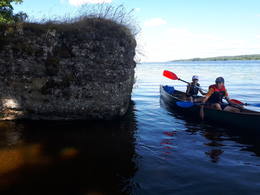Actor Harijs Liepiņš's memories of his service in the German army
The later popular actor Harijs Liepiņš was drafted into the German army and sent to Ķegums in the fall of 1944.
"We are taken to anti-aircraft batteries and training in Ķegums - a zone, in barracks near the power plant on the banks of the Daugava. On the first day of training, we are introduced to German iron discipline, it humiliates, destroys any self-esteem and spirit of protest.
...We are broken, mere unwilling screws that can be gradually fitted into the great military machine.
Finally, the historic moment arrives – the oath-taking to Hitler and the Wehrmacht. We stand in a closed line on the bank of the experienced Daugava. Wagner's music sounds over the loudspeakers, flags flutter. On the platform, a German colonel begins his solemn words, which are translated by a Latvian captain, and we have to repeat them with a raised hand. We reach the middle of the first sentence: “I, the young soldier of Great Germany…” – when the clear conscience of the Daugava and Stalin's “eagles” come to our aid. An attack by a bomber squadron interrupts the shameful ritual. The bombs explode, and all the officers and non-commissioned officers, together with the young soldiers, fall next to each other in the nearby potato fields. Thanks to the anti-aircraft attack balloons deployed at an altitude of 800 meters, there are few hits, and there is great panic. Wagner's "Twilight of the Gods" continues to sound amidst roars and whistles... After that, the air smelled of gunpowder for a long time, here and there it burned. The solemn ceremony was not repeated. And so, in a half-hearted way, my oath to the "leaders" ended, and I will never have to answer to any neo-fascist for breaking or failing to keep it in my life."
Andersone, R. 2004. Kegums hydroelectric power plant. p. 69.
Related timeline
Related topics
Related objects
German army concrete fire point at the Ķegums HPP reservoir at the mouth of the Žega River
Located in the Ķegums HPP reservoir at the mouth of the Žegums River (opposite the Žegums House), on its left bank. One of the most visually and scenically impressive and also better preserved concrete fire points washed by the waves of the Daugava. It can be seen from a greater distance. A footbridge has been built from the shore to the top of the fire point (overgrown with grass). Narrow-gauge railway (?) tracks are built into the concrete walls of the fire point. You can enter it from the footbridge. This is one of the fire points of the German army's World War I defense line on the left bank of the Daugava, which can be more or less traced along the entire length of the left bank of the Daugava. The aforementioned defense line is a large-scale military system that has not yet been truly evaluated as a single entity. The remains of the fire point can be viewed by boating along the Ķegums HPP.
German army concrete fire point on the upper bank of the Ķegums HPP opposite Anduli
It is located about 1.2 km east of a small stream widening (the stream flows into Lejasgrantiņi) at the top of the steep bank slope of the Ķegums HPP opposite Anduļi. The bank in this place is overgrown with forest and undergrowth, so only a keen observer will notice this fire point from the side of the reservoir. The fire point is well preserved, as it has not been damaged by bank erosion. This is one of the fire points of the German army's World War I defense line on the left bank of the Daugava River, which can be more or less traced along the entire length of the left bank of the Daugava River. The aforementioned defense line is a large-scale military system that has not yet been properly evaluated as a single entity. The fire point can be viewed by boating along the Ķegums HPP, as it is located on private territory.






